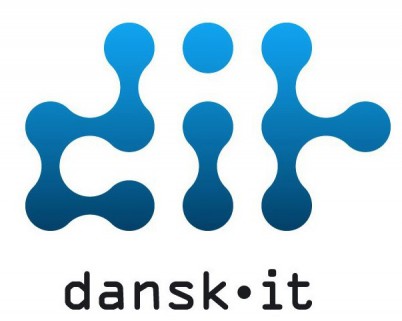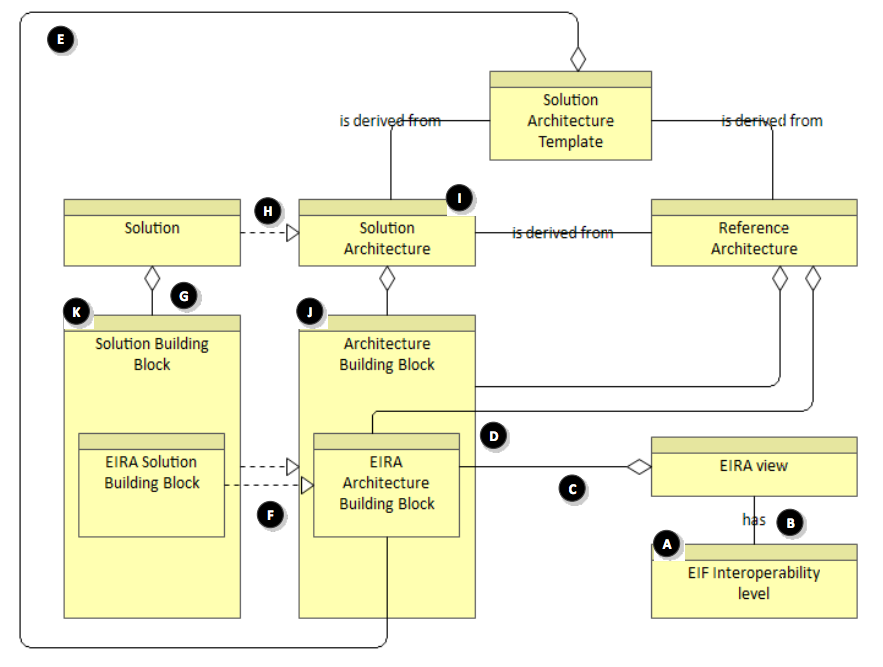CoE
A Trip to Automation Valley
 QualiWare and 17 other member companies of Manufacturing Academy of Denmark (MADE) went on an Industrie 4.0 study trip to Automation Valley in North Bavaria last week. The trip was arranged by MADE together with the local chamber of commerce and industry and the Royal Danish Consulate General in München.
QualiWare and 17 other member companies of Manufacturing Academy of Denmark (MADE) went on an Industrie 4.0 study trip to Automation Valley in North Bavaria last week. The trip was arranged by MADE together with the local chamber of commerce and industry and the Royal Danish Consulate General in München.
The Digital Factory
Siemens, one of Germany’s largest companies and the largest engineering company in Europe, has taken its own medicine – digitalization and Totally Integrated Automation (TIA) – and has built a digital factory in Amberg in Bavaria.

The facility is a prime example of advanced product automation and has received numerous awards. The Amberg factory already combines the real and virtual worlds: Products communicate with machines, and all production processes are optimally integrated and controlled via IT.
The factory is essentially a fully operational demonstrator for many of Siemens’ own products and brands. Since the factory actually produces critically-important equipment for digital factories, one could call it a factory factory, and one may start wondering whether we visited the real-world Cyberdyne (as known from the Terminator movies).
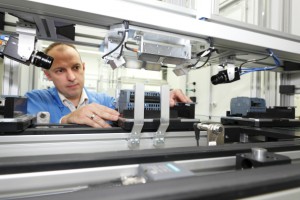 Siemens told us that they were quite content having reached a 75% level of automation in Armberg, and that it currently is neither feasible nor desirable to automate further in this kind of production.
Siemens told us that they were quite content having reached a 75% level of automation in Armberg, and that it currently is neither feasible nor desirable to automate further in this kind of production.
The continued human intervention will not disappear with the digital factory, but roles and competencies will change dramatically. Shop-floor work merges with administrative and analytical work, and desktops with computers now invade the shop-floor alongside the robots, sensors and augmentation systems. How the different roles and responsibilities change will depend on many things, not least organisational culture and politics. When sensors and big data analytics become the new supervisors, middle management must find new work, or become extinct, for example.
3D Printing
After huge Siemens we next visited FIT AG, an additive design and manufacturing (3D printing) company with (I think) 200 employees. They introduce ADM and themselves like this:
Additive Manufacturing (AM) is a disruptive manufacturing technology for complex parts in plastics and metal such as Aluminum, Titanium, tool steel, stainless steel, and Inconel. Different to traditional abrasive or forming technologies, additive manufacturing builds three-dimensional objects layer by layer. Leaving the known limitations of conventional production techniques far behind, these objects can be of almost any shape or geometry. Additive manufacturing is used efficiently for single parts as well as mass production. In order to exploit the full potential of additive manufacturing, its chances as well as specific challenges regarding design and technical issues must be well-known. With 20 years’ experience in this field, the FIT Group is an expert not only for AM, but the world-leading specialist for Additive Design and Manufacturing.
Here are some examples of their prints:
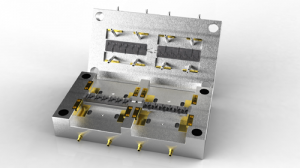


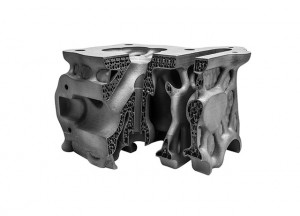
FIT uses leading-edge AM technologies and works closely with 3D printer vendors to become able to deliver ever more advanced products on ever more markets. FIT is growing fast, and we visited their new printing facility in Lupburg, which is already (partially) open for business, as Europe’s first commercial high volume additive manufacturing facility.
Additive Design and Manufacturing is an enabler of radical innovation, and FIT’s value proposition is basically that you can now produce and manufacture some designs that were previously if not impossible then impractical to produce. AM itself is today far from competitive to standardized mass-production, but is beginning to be interesting for mass-customization and complex product in higher volumes. But the real strength today is in rapid prototyping and design iterations for product innovations. For an example, see FIT’s case video about a race car cylinder.
Organizationally, ADM is to industrial designers/product engineers and production engineers/shop-floor what devops is to service designers/IT developers and IT service managers/IT operations. It is going to be interesting to see how this will work in an industrial setting, which has traditionally had very .
Green Factory
 The last visit was to the Institute for Factory Automation and Production Systems (FAPS) at Friedrich-Alexander-Universität Erlangen-Nürnberg (FAU) which is a research leader in cleantech. FAPS is involved with Green Factory Bavaria:
The last visit was to the Institute for Factory Automation and Production Systems (FAPS) at Friedrich-Alexander-Universität Erlangen-Nürnberg (FAU) which is a research leader in cleantech. FAPS is involved with Green Factory Bavaria:
The Green Factory in Bavaria combines the research expertise of all relevant fields within energy-efficient production disciplines, such as mechanical engineering, production engineering, electrical engineering, computer engineering, chemical engineering, materials science, and economics. These research fields consider all significant transformations of energy to movement, to lighting, to information processing. This even extends to for manufacturing processes as well as heating, cooling and air conditioning control, which are dedicated for the usage of energy in production, logistics and administration. With a clear focus on energy efficiency in production, the interdisciplinary collaboration of the Green Factory Bavaria is integrated into an internationally viable research network.
The FAPS team demonstrated a range of research results which, for example, use much less electricity than current solutions. Or less material. It should go without saying that such research is incredibly important at many levels – from “saving the planet” over “viable enterprise” to “profitable growth/competitive advantage”. A group of experts discussed the “digital green agenda” in Greening IT. As a registered user, you can download the book here.
Augmented Reality
 One of the days in Nürnberg was a networking day for Danish and German companies. Or DACH companies; one company I found particularly interesting is an Austrian company, Augmensys, that provides and develops Augmented Reality software for professional use in industrial environments.
One of the days in Nürnberg was a networking day for Danish and German companies. Or DACH companies; one company I found particularly interesting is an Austrian company, Augmensys, that provides and develops Augmented Reality software for professional use in industrial environments.
Established in 2011, Augmensys is a pioneer for efficient data management without frictional losses throughout the process industry. Their UBIK platform is an innovative mobile data management software with Augmented Reality support, made solely for use in enterprise scenarios.
Augmensys is currently focusing on tablets, but also works with helmets and smart-gadgets of various kinds. The sometimes rather special settings for the relevant usage scenarios – for example underground without GPS, wifi, etc – is a key challenge. Also, the human-device interaction is a challenge, since it’s not always practical to use, say, a tablet.
In some industrial (and other) settings, augmentation technologies are embedded in the environment and interact with machines, robots, sensors and other “things” – and people. For example, a Danish meat-processing facility uses laser projection for guiding the meat-cutters.
Enabling Industry 4.0
So, the Germans call all of the above Industrie 4.0:
When components communicate with the production equipment by themselves, or order a repair to be undertaken when needed – when people, machines and industrial processes are intelligently networked, that is “Industrie 4.0”.
Industrie 4.0 is a central element in the German government’s Digital Agenda program. The German manufacturing industry is, as our study trip showed, already fully engaged in realizing Industry 4.0.
The digital agenda is a global agenda, and Germany’s Industrie 4.0 is of course also a strong national agenda for German competitiveness in the global markets. With “players” such as Siemens and SAP, Industry 4.0 could be Germany’s export good #1.
There is however also a risk at stake: Maybe Industry 4.0 works better outside Germany? Or whichever variants other countries call their digitalization efforts.
The Danish delegation returned home with a lot of inspiration – both from the Germans but also from each other – and will continue working together to enable the continued digitalization of the Danish manufacturing industry. Which will probably continue to use Siemens and SAP as major suppliers for their digital platform.
Architecting the Digital Hospital
More than 10 billion Euros will be spent on 16 new hospital construction projects in Denmark. One of the larger projects, dubbed a “super-hospital,” is in Odense, where the budget is 1.3 billion Euros. The New Odense University Hospital (Nyt OUH) will be approximately 250.000 m2 and is scheduled to be ready in 2022. It will become the largest hospital in Denmark that is built from scratch.
Budget
1.3 €billion
Floor area
250.000 m2
New OUH is a green-field mega-project which will replace the existing university hospital (OUH). So on one hand, it is a rare opportunity to architect a digital enterprise “ground-up”, regardless of the existing built-environment, but on the other hand, it is also a significant transition challenge for the existing enterprise.
The overall vision for New OUH is:
A university hospital is a highly technological and knowledge intensive enterprise that depends on knowledge being shared and used optimally in the primary production – treatment of patients and research. Knowledge in the hospital must flow freely inside the networks and between the relevant operators and must be available at any time and in such a fashion that it can be utilized immediately.
New OUHs governing bodies have established an overall vision for the digital hospital:
The Digital Hospital is a composite term consisting of the word Hospital. This represents the core service – diagnosing and treatment of patients and thus the circuit of knowledge while the Digital is a supporting and developmental term to the core service. The Digital element in New OUH must be omnipresent and must ensure that New OUH can realize its vision and make full and optimal use of the knowledge circuit. In other words, the Digital hospital is a precondition for the knowledge circuit in New OUH.
Digital solutions at New OUH will be for all, to all, between all, everywhere – always.
For all
Digital solutions must support all users of the hospital and its functions. Concurrently, the digital solutions will help convert data into information to the benefit of the sharing of knowledge, treatment, care and research. The digital solutions must support exchange of information/communication as well between the different users, and deliver to such an extent that they support proper communication between the parties and in a fashion making it relevant for the information seeker. When the term “all” is used it refers to patients, next of kin, hospital employees, GPs, municipality and scientific researchers at the university.
To all
Digital solutions for all are regarded as any productive process at New OUH is digitally supported. Data, information and knowledge flow freely and automatically to all people as well as systems, thus supporting the hospital processes in the best possible way and at any time providing the employees with the necessary knowledge needed to perform their tasks. “To all” constitutes a movement from one operator to (“all”) another operator. This movement rep-resents knowledge shared transparently and automatically. Data, information and knowledge thus flow to and between all productive operators and processes at the hospital.
Between all
Digital solutions between all tie individuals, work processes and solutions together in a holistically orientated network2. In other words, we are talking about coherent sharing of information and knowledge between all operators in a network. “Between all” is thus regarding the coherence and integration of concepts. The digital elements is seen as coherence and integration on three levels: between individuals, between equipment, and between equipment and individuals. The digital hospital must contribute to information and knowledge being made available in such a way that it can be integrated and utilized between all operators and network in and around the hospital’s technical and productive processes.
Everywhere
Digital solutions “over all” mean that the solutions must be available and integrated for all, in and around the hospital, patients as well as external partners. This availability “everywhere” facilitates communication, sharing and creation of knowledge. Therefore “Everywhere” must not be viewed as a (narrow hospital based) concept but as including all partners (patients, scientific researchers, municipalities etc.) “Everywhere” covers, in other words, the geographical and organizational areas that participate in or around a specific productive process offered by the hospital to a patient or a group of patients. “Everywhere” thus facilitates both and organizational perspective, a process related perspective, and a geographical perspective. This means that digital solutions “everywhere” must be an organizational part of the entire hospi-tal, support all productive processes in such a way that these can be utilized in the best possible way regardless of geographical location.
Always
Digital solutions must always be present and support the user at any given time to be able to procure the requested information – regardless of place and time. This means that the digital solutions support availability of information for the user at the time the information is requested. This means that during an operation the surgeon can pull vital information that the researcher has unlimited access to quality data in his field. That data is available regardless if the user is present at the hospital, the university or outside.
New OUH has chosen QualiWare’s digital business design platform for the ongoing architecture and design work on the digital enterprise. QualiWare is already used at the existing OUH for asset management in several clinical areas.
The New OUH enterprise architecture team will over the next 6 years need to flesh out actionable digital business design, and realize the digital hospital vision. QualiWare Center of Excellence will support the EA team in these efforts.
In future blogs, we will offer more updates and elaborations on the digital hospital.
Ten notable books from 2015
One of my routines around New Year is to look back at the books brought to the market in the last year that caught my attention. In this blog post, I will share my thoughts about the ten most notable books of the year.
Notable 2015 additions to the enterprise architect’s bookshelf:
 Business Architecture Management: Architecting The Business For Consistency And Alignment by Daniel Simon And Christian Schmidt presents a comprehensive overview of enterprise architecture management with a specific focus on the business aspects. While recent approaches to enterprise architecture management have dealt mainly with aspects of information technology, this book covers all areas of business architecture from business motivation and models to business execution. Simon and Schmidt have done an excellent work editing this book, which has contributions from both academics and practitioner. I’m particularly fond of Adrian Apthorp’s contribution.
Business Architecture Management: Architecting The Business For Consistency And Alignment by Daniel Simon And Christian Schmidt presents a comprehensive overview of enterprise architecture management with a specific focus on the business aspects. While recent approaches to enterprise architecture management have dealt mainly with aspects of information technology, this book covers all areas of business architecture from business motivation and models to business execution. Simon and Schmidt have done an excellent work editing this book, which has contributions from both academics and practitioner. I’m particularly fond of Adrian Apthorp’s contribution.
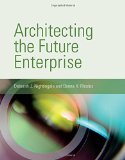 Architecting The Future Enterprise by Deborah J. Nightingale And Donna H. Rhodes offers a framework for enterprise transformation. Successful transformation, the MIT professors believe, starts with a holistic approach, taking into consideration all facets of the enterprise and its environment rather than focusing solely on one factor — information technology, for example, or organizational structure. This is architecting the future enterprise: creating a blueprint for what the enterprise will look like after the transformation. For this, Nightingale and Rhodes introduce the ARIES (Architecting Innovative Enterprise Strategy) framework.
Architecting The Future Enterprise by Deborah J. Nightingale And Donna H. Rhodes offers a framework for enterprise transformation. Successful transformation, the MIT professors believe, starts with a holistic approach, taking into consideration all facets of the enterprise and its environment rather than focusing solely on one factor — information technology, for example, or organizational structure. This is architecting the future enterprise: creating a blueprint for what the enterprise will look like after the transformation. For this, Nightingale and Rhodes introduce the ARIES (Architecting Innovative Enterprise Strategy) framework.
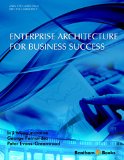 Enterprise Architecture for Business Success by Inji Wijegunaratne, George Fernandez, and Peter Evans-Greenwood is a solid ebook based on scientific work, which I’m familiar with from my time as editor as Journal of Enterprise Architecture. The authors argue that EA has evolved to become a prominent presence in today’s information systems and technology landscape. The EA discipline is rich in frameworks, methodologies, and the like. However, the question of ‘value’ for business ;professionals remains largely unanswered – that is, how best can Enterprise Architecture and Enterprise Architects deliver value to the enterprise? The Australian researchers makes a very solid analysis and presents an interesting approach to the value of EA discussion.
Enterprise Architecture for Business Success by Inji Wijegunaratne, George Fernandez, and Peter Evans-Greenwood is a solid ebook based on scientific work, which I’m familiar with from my time as editor as Journal of Enterprise Architecture. The authors argue that EA has evolved to become a prominent presence in today’s information systems and technology landscape. The EA discipline is rich in frameworks, methodologies, and the like. However, the question of ‘value’ for business ;professionals remains largely unanswered – that is, how best can Enterprise Architecture and Enterprise Architects deliver value to the enterprise? The Australian researchers makes a very solid analysis and presents an interesting approach to the value of EA discussion.
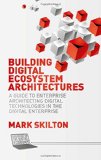 Building the Digital Enterprise and Building Digital Ecosystem Architectures are two volumes in Mark Skilton’s series of books on Business in the Digital Economy. I basically regard these two books as one; the first one being an introduction to “digital”; the second book is clearly most relevant for EA readers. Skilton is involved with the Open Group work on Open Platform 3.0, and lead author on some of the work there. The second book extends on this work. As such, the whole book series is solidly anchored in classic, IT-centric EA. But it moves ahead on several accounts, including the monetization and benefit realization requirements underlying much current EA work.
Building the Digital Enterprise and Building Digital Ecosystem Architectures are two volumes in Mark Skilton’s series of books on Business in the Digital Economy. I basically regard these two books as one; the first one being an introduction to “digital”; the second book is clearly most relevant for EA readers. Skilton is involved with the Open Group work on Open Platform 3.0, and lead author on some of the work there. The second book extends on this work. As such, the whole book series is solidly anchored in classic, IT-centric EA. But it moves ahead on several accounts, including the monetization and benefit realization requirements underlying much current EA work.
 Chess And The Art Of Enterprise Architecture by Gerben Wierda is a novel approach to writing an EA book. Gartner had the author speak about it at their EA Summit in London, and the book’s message is that Enterprise Architecture is the discipline of managing the complexities of the Business-IT landscape. “Enterprise chess” is used mainly metaphorically, but clearly Wierda is an avid chess player and sometimes ends up being a bit “nerdy” about it (although nowhere as nerdy as he becomes in his ArchiMate book). But Wierda is an experienced practitioner and shares happily his experiences. I think many, both new and experienced, practitioners will find it useful and interesting.
Chess And The Art Of Enterprise Architecture by Gerben Wierda is a novel approach to writing an EA book. Gartner had the author speak about it at their EA Summit in London, and the book’s message is that Enterprise Architecture is the discipline of managing the complexities of the Business-IT landscape. “Enterprise chess” is used mainly metaphorically, but clearly Wierda is an avid chess player and sometimes ends up being a bit “nerdy” about it (although nowhere as nerdy as he becomes in his ArchiMate book). But Wierda is an experienced practitioner and shares happily his experiences. I think many, both new and experienced, practitioners will find it useful and interesting.
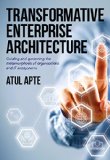 Although I am yet to read the whole book, I’ll include Transformative Enterprise Architecture: Guiding And Governing The Metamorphosis Of Organizations And IT Ecosystems by Atul Apte which was released (self-published) on Christmas Eve 2015. Apte starts out by saying that the age of transformation is upon us. And for corporate IT departments, supporting and sustaining enterprise architecture requires a fundamentally new approach. Transformative Enterprise Architecture has the solution, he argues. He presents a new “homegrown” methodology that “boldly redefines the characteristics and competencies that every large-scale IT team must develop to function successfully”.
Although I am yet to read the whole book, I’ll include Transformative Enterprise Architecture: Guiding And Governing The Metamorphosis Of Organizations And IT Ecosystems by Atul Apte which was released (self-published) on Christmas Eve 2015. Apte starts out by saying that the age of transformation is upon us. And for corporate IT departments, supporting and sustaining enterprise architecture requires a fundamentally new approach. Transformative Enterprise Architecture has the solution, he argues. He presents a new “homegrown” methodology that “boldly redefines the characteristics and competencies that every large-scale IT team must develop to function successfully”.
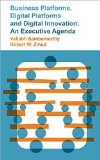 Business Platforms, Digital Platforms and Digital Innovation: An Executive Agenda by Vallabh Sambamurthy and Robert Zmud is the second book of a three book series on digitalization management. This book discusses how competitive success is increasingly dependent on the enterprise capabilities to simultaneously exploit their installed business platforms and undertake digital innovation, i.e., what Gartner calls bimodal IT. It is not clear to me what the third book will cover, and when it comes, but I hope the authors will go deeper into the architectural challenges, and expand on the role of enterprise architecture.
Business Platforms, Digital Platforms and Digital Innovation: An Executive Agenda by Vallabh Sambamurthy and Robert Zmud is the second book of a three book series on digitalization management. This book discusses how competitive success is increasingly dependent on the enterprise capabilities to simultaneously exploit their installed business platforms and undertake digital innovation, i.e., what Gartner calls bimodal IT. It is not clear to me what the third book will cover, and when it comes, but I hope the authors will go deeper into the architectural challenges, and expand on the role of enterprise architecture.
 Digital To The Core: Remastering Leadership For Your Industry, Your Enterprise, And Yourself by Mark Raskino and Graham Waller is Gartner’s own “flagship” book on digital business, authored by two of their leading analysts. “In this pioneering era,” the authors argue, “successful leaders are those who can master the key macro forces that drive digitalization, and then lead their organizations at three distinct levels: industry, enterprise, and self”. The authors describe the three primary disruptive forces of the digital era: Resolution Revolution, Compound Uncertainty, and Boundary Blurring.
Digital To The Core: Remastering Leadership For Your Industry, Your Enterprise, And Yourself by Mark Raskino and Graham Waller is Gartner’s own “flagship” book on digital business, authored by two of their leading analysts. “In this pioneering era,” the authors argue, “successful leaders are those who can master the key macro forces that drive digitalization, and then lead their organizations at three distinct levels: industry, enterprise, and self”. The authors describe the three primary disruptive forces of the digital era: Resolution Revolution, Compound Uncertainty, and Boundary Blurring.
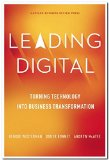 Although it is from 2014, I here also want to mention Leading Digital by George Westerman, Didier Bonnet, and Andrew McAfee (MIT, Capgemini, MIT). This is a must for “digital business” readers. Based on a study of more than four hundred global firms the book shows what it takes to become a Digital Master. It explains successful transformation in a clear, two-part framework: where to invest in digital capabilities, and how to lead the transformation. During 2015 McAfee used the classic tale of the invention of chess and the 33rd square of a chess board in notable keynotes, including at Gartner’s Symposium in Barcelona, to explain why “digital” is so important today (the second half of the chess board).
Although it is from 2014, I here also want to mention Leading Digital by George Westerman, Didier Bonnet, and Andrew McAfee (MIT, Capgemini, MIT). This is a must for “digital business” readers. Based on a study of more than four hundred global firms the book shows what it takes to become a Digital Master. It explains successful transformation in a clear, two-part framework: where to invest in digital capabilities, and how to lead the transformation. During 2015 McAfee used the classic tale of the invention of chess and the 33rd square of a chess board in notable keynotes, including at Gartner’s Symposium in Barcelona, to explain why “digital” is so important today (the second half of the chess board).
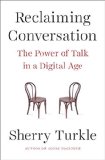 Reclaiming Conversation by Sherry Turkle is subtitled The Power of Talk in a Digital Age. “We live in a technological universe in which we are always communicating. And yet we have sacrificed conversation for mere connection,” the MIT media scholar argues. Based on five years of research and interviews in homes, schools, and the workplace, Turkle argues that we have come to a better understanding of where our technology can and cannot take us and that the time is right to reclaim conversation. This is perhaps the most important message of the year.
Reclaiming Conversation by Sherry Turkle is subtitled The Power of Talk in a Digital Age. “We live in a technological universe in which we are always communicating. And yet we have sacrificed conversation for mere connection,” the MIT media scholar argues. Based on five years of research and interviews in homes, schools, and the workplace, Turkle argues that we have come to a better understanding of where our technology can and cannot take us and that the time is right to reclaim conversation. This is perhaps the most important message of the year.
Just at Turkle’s book is a healthy “antidote” to Gartner’s and others’ uncritical thinking, it may be necessary to add several more books. I’ve for example liked Surviving AI: The promise and peril of artificial intelligence by Calum Chase and Rise Of The Robots: Technology and the Threat of Mass Unemployment by Martin Ford, both of which should also be mandatory reading for the enterprise architects (and many others).
My hope for 2016 is that we will see more books following the line of the first two on my list above. That is, books that deal with architecting the enterprise. Can’t we just all agree that 2015 taught us that every company is digital, and get on with it? There are many more interesting issues ahead.
PS: Amazon should stop (remove) this book spammer.
Enterprise Architecture Trends 2015
I’m looking forward to speaking about trends in enterprise architecture at the EA2015 conference on 4 November in Copenhagen. Having spoken at this annual conference over the past several years, it is my annual “state-of-the-union” address to the Danish EA community.
This year, I will talk about several trends and issues. The outline of the lecture looks like this:
- The current state of #EntArch
- So, is there a problem?
- “The only thing that’s changed, is everything”
- EA scholary analysis
- EA scope creep
- Gartnertology
- We’re not in Kansas anymore
- Enterprise Investment
- Enterprise Design
- Suggestions
You can get my slides here, but most of them are not very informative on their own.
Although I use different evidence, many of my points are also expressed in my crossroads blog post and article. But I will also bring up several other points. I’ve even invented a new word: Gartnertology. This I use to describe how Gartner is becoming something akin to a religious cult.
I will of course here refer to Kuno Brodersen’s recent blog post about Gartner’s tool assessment practice, but will focus more on Gartner’s recent messages about digital business, and discuss these. And then rather quickly move on to something more interesting, including enterprise investment and enterprise design.
All in all, a lot of content for a 45 minutes lecture. So participants will be told to fasten their seat-belts.
Enterprise Architecture at the Crossroads
Enterprise Architecture is facing several challenges as a discipline and a practice. In this blog post, John Gøtze outlines four central challenges, and discusses what should be done. He suggests that enterprise architecture management must focus on enterprise collaboration.
The Challenges
The discipline Enterprise Architecture (EA) is at a crossroads, facing four challenges:
- The first challenge is to overcome the narrowness of scope of present practice in EA, and re-gain the coverage of the entire business on all levels of management, and a holistic and systemic coverage of the enterprise as an economic entity in its social and ecological environment.
- The second challenge is how to face the problems caused by complexity that limit the controllability and manageability of the enterprise as a system.
- The third challenge is connected with the complexity problem, and describes fundamental issues of sustainability and viability.
- Following from the third, the fourth challenge is to identify modes of survival for systems, and dynamic system architectures that evolve and are resilient to changes of the environment in which they live.
A recent (in-press) peer-reviewed article, Enterprise Engineering and Management at the Crossroads – the result of a collaborative effort between eleven authors from four continents – discusses these four challenges and the state of the art of the discipline of Enterprise Architecture, with emphasis on the challenges and future development opportunities of the underlying information system, and its IT implementation, the Enterprise Information System (EIS).
Responses
The article provides pointers to possible radical changes to models, methodologies, theories and tools in EIS design and implementation, with the potential to solve these grand challenges:
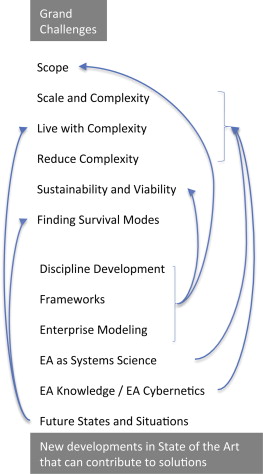
Towards Solutions
The article argues that EA needs to embrace full or broad views of the enterprise as per the original vision of the discipline’s mission that originated in manufacturing (e.g. computer integrated manufacturing systems), and the parallel developments in information systems and software development. This division between information systems, system science, and manufacturing & industrial engineering needs to be resolved as it is still felt today and hampers the discipline of EA as a whole. Any credible development of the discipline must equally cover and explain deliberate change and evolutionary change in a system of socio-technical systems, the production & service to the customer, and the management & control of the enterprise, the technical resources (logistics, manufacturing machinery, communication systems, computer systems), human resources, financial resources, and assets of all other kind (knowledge & information assets, buildings and grounds, and various intangibles).
As EA is moving up the hierarchy from technical to management levels, the language and skill set of its practitioners has to change to better reflect the specific needs and language of the management community. This needs to be reflective in terms of not only language, but also culture. The focus must be on views of the organisation that management science is interested in (People, Capability, Place, Role, Relationships and Trust, Risk, Finance, Brand Strategy, Knowledge Management) rather than detailed, possibly local technical views of the organisation.
A central concern in EA is the development of the information system that implements a coherent, aware behaviour of the enterprise on any scale. It is acceptable (even desirable) that the implementation of these properties should not have a single locus, so that the system should display these properties without a single subsystem or system component being responsible for them. If awareness and coherency are emergent properties of the enterprise, it is likely that the enterprise (and its information system) would be more resilient in terms of being able to maintain these systemic properties.
A New Paradigm for EA
The article suggests a new paradigm for EA:
It is clear that the future is not in EA reinventing the complete gamut of management models, but it is in providing a unifying platform through which the multiple models used in the various life cycle phases and in the various stages of the enterprise’s life history can be combined. The combination needs a new paradigm though, as current EA methodologies struggle with the reality of complex relationships among models present at different abstraction levels. In essence, guided evolution of the enterprise requires that enterprise modelling not be seen as a top-down or bottom up process, but as a powerful problem finding and problem solving tool that supports transformational activities both on the strategic and operational levels.
In my article from 2013, The Changing Role of the Enterprise Architect, I argue that in facing ‘wicked problems’, enterprise architects must focus more on problem-finding than problem-solving; true craftsmen look at situations in a problem-finding manner, rather than blindly applying the same method and tool every time to what may be a new and interesting challenge.
Enterprise architecture practice must be collaborative, and enterprise architects should be cooperative in character, able to engage in many kinds of communication and collaboration. I argue that enterprise architects must have both:
- dialectic skills and competencies in resolving conflicts, creating consensus, synthesis and common understanding, detecting what might establish that common ground, and the skill of seeking the intent rather than just reading the face value of the words, and
- dialogic skills including listening well, behaving tactfully, finding points of agreement, managing disagreement, and avoiding frustration in a difficult discussion.
Jason Uppal picks up on this in his lecture at a recent EA conference.
The dialectic/dialogic distinction is of course a classic discourse in educational research (see for example Rupert Wegerif, Richard Paul, and Andrew Ravenscroft) and generally throughout the critical social sciences (“Bakhtinian dialogic and Vygotsky’s dialectic”) ever since Hegel.
In Together: The Rituals, Pleasures, and Politics of Cooperation sociologist Richard Sennett states that the distinction between dialogic and dialectic is fundamental to understanding human communication. Sennett says that dialectic deals with the explicit meaning of statements, and tends to lead to closure and resolution. Whereas dialogic processes, especially those involved with regular spoken conversation, involve a type of listening that attends to the implicit intentions behind the speaker’s actual words. Unlike a dialectic process, dialogics often do not lead to closure and remain unresolved. Compared to dialectics, a dialogic exchange can be less competitive, and more suitable for facilitating cooperation. Sennett explains further in a lecture at Harvard: The Architecture of Cooperation.
The Importance of Enterprise Collaboration
Cooperation and collaboration are closely related concepts, and often thought of as synonymous. In fact, they are quite different.
Oscar Berg‘s Collaboration Pyramid may explain the difference:
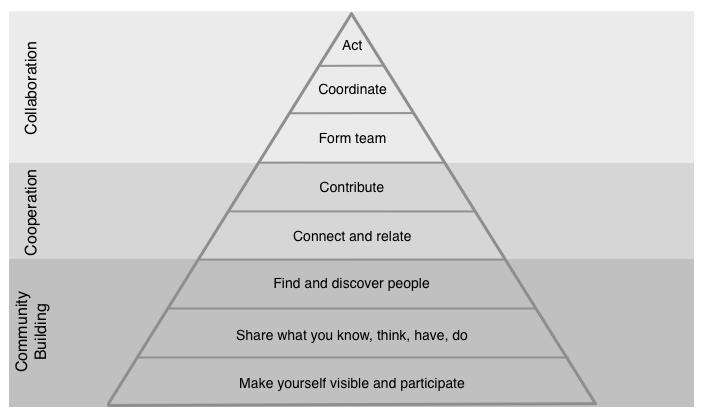
Berg distinguishes between the three layers in this way:
- The community is the enterprise seen as a group of individuals that share the same purpose, vision and values. It is about shared attitudes and behaviors within the enterprise, or the culture if you like. It is also about the individual’s ability to be seen, participate and be recognized, all of which are fundamental for developing a sense of belonging, identity, and self-confidence.
- Cooperation is about people enabling each other to do something, for example by providing a person with information or other resources that make the person more able to perform a task. Cooperation can be seen as the opposite of selfishness and competition. People help each other out for some mutual benefit.
- Collaboration is about a team of people that work closely together to achieve a certain goal. It can be a permanent team, like a production unit at an assembly line, or temporary team, like a project team. The team would most likely have a formally appointed leader, someone who is responsible for the planning, coordination, follow-up, and communication within the team as well as the world outside the team.
Enterprise collaboration is a term that covers all these three all-important concepts of the “social” enterprise. The term is often mistakenly used to cover social networking tools and intranet, but should be seen as a wider concept and a more comprehensive platform for the enterprise, wherefrom strategic alignment and viable process and information flows are tangible outcomes.
In our Collaboration whitepaper, we explain further how QualiWare is enabling our customers to work with collaboration in their enterprise architecture work.
BPM Professional Certification Training
Launch in Denmark: 2-6 November 2015 in Farum.
Complete 40 hours of coursework (3 courses, 5 days) to earn your business process management professional certificate and gain the practical tools and background required to work on a team of BPM Process professionals.
![]() The BPTA Professional Certificate Program is aligned with the International Association of Business Analysis (IIBA®) Business Analysis Body of Knowledge (BABOK® V2.0) and is endorsed by the IIBA.
The BPTA Professional Certificate Program is aligned with the International Association of Business Analysis (IIBA®) Business Analysis Body of Knowledge (BABOK® V2.0) and is endorsed by the IIBA.
2nd Enterprise Design Retreat
On 5-7 October 2015, eda.c and QualiWare will arrange the 2nd Enterprise Design Retreat at Héraðsskólinn in Iceland. Following our first edition two years ago in Barcelona, we will continue to jointly shape the emerging field of Enterprise Design and exchange among leading practitioners of Enterprise and Business Architecture, Customer and User Experience, and Design Thinking and practice.
The retreat is open for registration, but has a limited number of seats.
Day 1: Enterprise Transformation
Transforming complex organizations is a shared challenge among Enterprise Design practitioners. We will explore how to develop a holistic view on the enterprise as an intertwined entity of social dynamics, hard and soft structures, and employee experience. Topics include:
- Employee Experience
- Political-Cultural Change Initiatives
- Top Activities, Tasks and Tools
- Digital Workplace and Social Enterprise
Day 2: Enterprise Modelling
In order to look at enterprise ecosystems including internal and external perspectives, we need to create multiple models from different viewpoints, looking at a variety of aspects. On day 2 we will look into modelling techniques and activities, addressing topics such as:
- The Modelling Journey
- Killer Models and Techniques
- Modelling Languages and Standards
- Complexity and Systems Thinking
Day 3: Enterprise Innovation
To have impact on the future of enterprises and their interactions with key actors, Enterprise Design must go beyond mere optimization of the already existing. On the last day we will focus on enterprise innovation, rapid and entrepreneurial design, and reshaping brands and customer experiences through dynamic approaches:
- Brand and Customer Experience
- Design Sprints, Lean+Agile Design Thinking and practice
- Entre-/Intrapreneurship
- Generative/Algorithmic Systems and Platforms
Included in the program is a sightseeing tour of The Golden Circle.
The cost of participation is € 400 which includes the complete 3 day program, lunches, dinners, sightseeing tour and airport transport. Accommodation on site costs about € 70/night. Make your reservation with us for best rates. Get in touch with Edward Hansen from QualiWare for more information.
European Interoperability Reference Architecture
European Interoperability Reference Architecture
The European Interoperability Reference Architecture (EIRA) is
an architecture content metamodel defining the most salient architectural building blocks (ABBs) needed to build interoperable e-Government systems.
On 8 June 2015, release 0.9.0 beta of the EIRA entered an eight-week public review period. Stakeholders working for public administrations in the field of architecture and interoperability were invited to provide feedback.
What is EIRA?
The EIRA provides a common terminology that “can be used by people working for public administrations in various architecture and system development tasks“. The EIRA initiative is part of Action 2.1 of the ISA Programme.
The EIRA is a four-view reference architecture for delivering interoperable digital public services across borders and sectors. It defines the required capabilities for promoting interoperability as a set of architecture building blocks (ABBs). The EIRA has four main characteristics:
- Common terminology to achieve a minimum level of coordination: It provides a set of well-defined ABBs that provide a minimal common understanding of the most important building blocks needed to build interoperable public services.
- Reference architecture for delivering digital public services: It offers a framework to categorise (re)usable solution building blocks (SBBs) of an e-Government solution. It allows portfolio managers to rationalise, manage and document their portfolio of solutions.
- Technology- and product-neutral and a service-oriented architecture (SOA) style: The EIRA adopts a service-oriented architecture style and promotes ArchiMate as a modelling notation. In fact, the EIRA ABBs can be seen as an extension of the model concepts in ArchiMate.
- Alignment with EIF and TOGAF: The EIRA is aligned with the European Interoperability Framework (EIF) and complies with the context given in the European Interoperability Strategy (EIS) . The views of the EIRA correspond to the interoperability levels in the EIF: legal, organisational, semantic and technical interoperability. Within TOGAF and the Enterprise Architecture Continuum, EIRA focuses on the architecture continuum. It re-uses terminology and paradigms from TOGAF such as architecture patterns, building blocks and views.
EIRA in one picture
The figure below provides a high-level overview of the four views in EIRA. Each of the four views consists of a set of Architecture Building Blocks (ABBs) and relations pertaining to the legal, organisational, semantic and technical domain of an Interoperable European Architecture. Each view has entry and exit points from one view to another.
The legal, organisational, semantic and technical domains are the classic European interoperability concerns. The EIRA defines building blocks for each view.
The views





In addition, a new Interoperability specification underpinning view has been added as an additional view, depicting architecture building blocks of the different views as a taxonomy of interoperability specifications:

EIRAs raison d’etre?
The key concepts of the EIRA and their relationships are described here:
The following list explains the different relationships:
A. The EIRA is derived from the European Interoperability Framework (EIF);
B. The EIRA has one view for each EIF interoperability level;
C. Each EIRA view contains several EIRA ABBs;
D. EIRA ABBs can be used to create reference architectures;
E. A SAT addresses a certain interoperability need. It consists of a sub-set of the most important EIRA ABBs and is derived from a reference architecture;
F. An EIRA SBB realizes one or more EIRA ABB;
G. A (interoperable) solution consists of one or more SBBs;
H. A (interoperable) solution realizes a solution architecture;
I. A solution architecture can be derived from a SAT or directly from a reference architecture;
J. As the EIRA focuses only on the most important ABBs needed for interoperability, other ABBs (= non-EIRA ABBs) can exist;
K. Similar to ABBs, non-EIRA SBBs can exist next to EIRA SBBs.
Release 0.9 of the EIRA does not provide as much detail about the SBBs as it does on the ABBs. This will be done in another project. Also see the SBB template document.
Further information about the EIRA can be obtained in the document ‘An introduction to the European Interoperability Reference Architecture v0.9.0’ (EIRA_v0.9.0_beta_overview.pdf). The release consists of the following release components:
- EIRA_v0.9.0_beta.archimate: Archi file containing the EIRA ArchiMate model.
- EIRA_v0.9.0_beta.html: HTML version of the EIRA ArchiMate model.
- EIRA_v0.9.0_beta_overview.pdf: PDF document containing an introduction to the EIRA, including its key concepts, used ArchiMate notation, tool support, and views.
- EIRA_v0.9.0_beta_ABBs: An HTML file containing the definitions of the architecture building blocks.
- EIRA_v0.9.0_beta_release_notes.pdf: PDF document containing the release notes.
- EIRA_v0.9.0_beta_release_document_set.zip: Zip file containing each of the above mentioned files.
Quick analysis of EIRA
EIRA lists 161 architecture building blocks. Of these, more than half are technical:
- 82 Technical View (27 Application and 55 Infrastructure)
- 26 Organisational View
- 19 Semantic View
- 18 Legal View
- 6 Interoperability View
- 10 Deprecated (11 if ABB59 Logging Service included – not marked in View:Deprecated but in Status).
The building blocks are described via selected archimate model concepts, of which four are used a lot:
- 40 archimate:ApplicationService
- 34 archimate:BusinessObject
- 26 archimate:ApplicationComponent
- 18 archimate:DataObject
Other model concepts are also used:
- 6 archimate:BusinessProcess
- 5 archimate:Contract
- 4 archimate:BusinessActor
- 3 archimate:BusinessRole
- 3 archimate:InfrastructureService
- 3 archimate:Network
- 3 archimate:Node
- 2 archimate:ApplicationInterface
- 1 archimate:BusinessFunction
- 1 archimate:BusinessInteraction
- 1 archimate:BusinessInterface
- 1 archimate:BusinessService
So, looking at the big picture, EIRA is perhaps a bit “heavy” on the technology side of interoperability, but does cover the four layers. In particular, EIRA establishes a set of views across the four layers. In doing so, it has to “embrace and extend” ArchiMate.
EIRA and ArchiMate
EIRAs commitment to ArchiMate is somewhat courageous. And somewhat creative, for example:
- EIRAs Business Capability is covered by archimate:BusinessFunction
- EIRAs Business Information Exchange is covered by archimate:BusinessInteraction
A Business Capability is the expression or the articulation of the capacity, materials and expertise an organization needs in order to perform core functions. Enterprise architects use business capabilities to illustrate the over-arching needs of the business in order to better strategize IT solutions that meet those business needs.
A Business Information Exchange is a piece of business data or a group of pieces of business data with a unique business semantics definition in a specific business context [ISO15000-5, UN/CEFACT CCTS].
These are work-arounds to two well-known ArchiMate limitations.
The archimate:BusinessObject is also quite busy, and for example covers these ABBs:
- Business Rule
- Business Information
- Organisational Procedure
- Organisational Structure
Again, work-arounds to current ArchiMate limitations.
EIRAs ABBs have changed with each release. Deprecated ABBs in the 0.9 beta include:
- Business Process
- Business Process Model
- Business Transaction
- Licensing and Charging Policy
- Privacy Policy
- Metadata Management Policy
- Data Routing Service
- Data Routing Component
- Information Security Policy
- Data Quality Policy
- Logging Service?
So, Business Process and Business Process Model are deprecated, but the archimate:BusinessProcess model concept is used several times, namely for these ABBs:
- Public Policy Cycle
- Definition of Public Policy Objectives
- Formulation of Public Policy Scenarios
- Impact Assessment
- Public Policy Implementation
- Public Policy Evaluation
ArchiMate of course allows for a certain amount of flexibility (ArchiMate 2.1, Chapter 9 Language Extension Mechanisms), but the creativity can be dangerous, expecially in an interoperability context.
EIRA is an many ways ahead of ArchiMate. The challenge is that ArchiMate is under continuous development, and is likely to change on exactly these areas in future versions (see chapter 12.1 in the ArchiMate 2.1 spec). So EIRAs current notation standard should be seen as a temporary “fix”.
A note of caution
EIRA has obviously selected a winner of the longstanding Process vs Capability Debate. Eradicating processes is rather bold, and contrary to advice from experts like Roger Burlton, Paul Harmon, Alan Ramias and Andrew Spanyi, and Keith Swenson. While it is laudable to focus on capabilities, the use of capabilities should not be seen as an alternative to using processes and business process models. Both are needed.
EIRA and Open Data
The EIRA model is available as an Archi file. The data is also available in Archi-produced HTML and images.
From a maturity standpoint, this is only just acceptable. Even an Excel sheet version would be better, but better would be “raw data” available in a range of formats, possible as an api.
Of course, The Open Group is working on an ArchiMate Model Exchange File Format, and has sponsored the development of an Archi plugin for exporting to that format.
Apart from listing a few generic and rather useless Dublin Core metatags (in the HTML table), the current EIRA model is weak on metadata provision. EIRA could, for example, have used Data Catalog Vocabulary (DCAT) and Asset Description Metadata Schema (ADMS), and the team may want to check out this guide.
Interoperable frameworks?
EIRA does not have any mapping to any other framework.
The Legal and the Organisational views are less conventional as architecture views go. The Semantic, Application (Technical) amd Infrastructure (Technical) views are classic architecture views in many EA frameworks. A comparison with established frameworks seems to be a good idea.
A key part of the US Federal Enterprise Architecture Framework Version 2 (FEAF-II) is the Consolidated Reference Model, which equips the US Federal Government and its Federal agencies with a common language and framework to describe and analyze investments. It consists of a set of interrelated reference models that describe the six sub-architecture domains in the framework: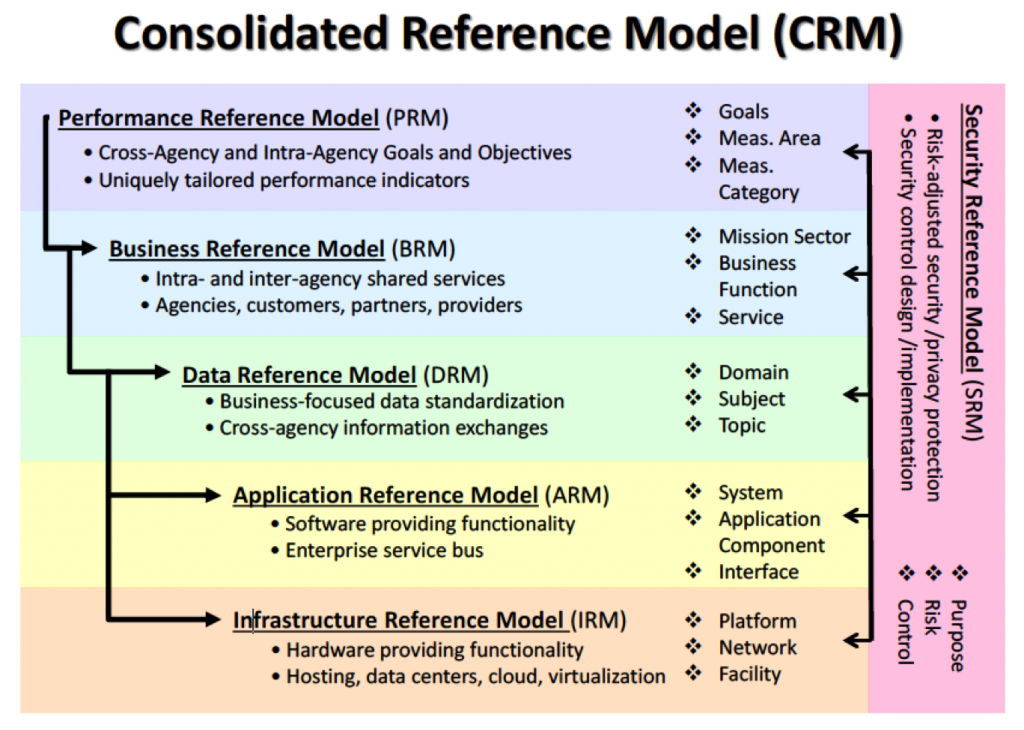
- Strategy
- Business
- Data
- Applications
- Infrastructure
- Security
EIRAs Legal view is roughly equivalent to FEAF-IIs Strategy (Performance Reference Model), and EIRAs Organisational view roughly equivalent to FEAF-IIs Business Reference Model.
Contentwise, EIRA and FEAF-II use these two layers in different ways:




EIRAs model scope is wider than FEAF-IIs, but FEAF-II is more comprehensive as a classification scheme.
EIRA should consider taking inspiration from FEAF-II, and at least add a security view. If anything, such view should become mandatory for all European governments.
Towards EIRA 1.0
The 0.9 release of EIRA is a big step forward for reference architecture work in European governments.
QualiWare proposes a rapid consolidation and documentation process, and then releasing Version 1.0. EIRA should not await the next version of ArchiMate, but rather run with well-documented revision control.
QualiWare is committed to supporting international governments in their interoperability work. QualiWare fully supports using ArchiMate 2.1. If customer demand requires it, the “EIRA ArchiMate” approach can easily be supported.
EA 2015 Copenhagen
The Danish IT Society runs its annual EA conference on 4th November, 2015.
John Gøtze will speak at the conference. The final program is still under development. Click the banner to see the conference website.




